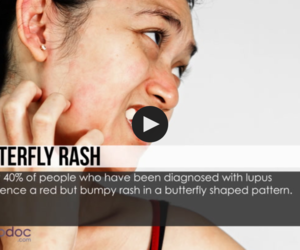Netflix's "Queer Eye” Helps Lupus Patient Learn How to Love Himself
Netflix's hit show "Queer Eye" helps a lupus patient be more confident in his own skin.

Photo: Netflix
Netflix's hit reality TV show “Queer Eye” is about fighting for acceptance, tolerance and learning from each other. The show is a representation of LGBTQ culture and proves that it is human to be tolerant and recognize that everyone is different. Simply, “Queer Eye” is not about learning how to be “queer” or gay, but how to tolerate everyone – their health, confidence, tolerance issues.
The first episode, the best place to start a TV series, begins by introducing the viewing audience to the millennial Fab Five. The Fab Five is a handful of men with specific talents who must come together to make the show work. You have Antoni, the show's food expert; Karamo, the show’s king of the ‘culture’; Tan, an expert in fashion; Bobby, who specializes in interior design; and Jonathan, the show's grooming extraordinaire.
Every member of the group seems like they were best friends for life, especially since their personalities on the show mesh beautifully with one another. However, they had never met each other before the show's first taping.
The way they interact with one another is certainly special, and they make you wish that you were part of the group!
Do you know how to watch Netflix offline on Mac and other devices? It’s quite simple.
Revelations about yourself: Why Grandpa Tom's episode is worth talking about
The series kicks off with Grandpa Tom, an aficionado of old cars and Mexican food. Tom is perfect; he doesn’t care who or what you are, all he wants is to find someone to watch TV with him. Grandpa Tom also has lupus, which is a conundrum itself. Tom is not a perfect 30-something guy, but a 57-year-old man with a medical condition that is known to cause depression and self-esteem issues.
Tom’s character is portrayed as a grumpy old man with a bushy beard, who calls himself fat and ugly. Being self-depreciating is not typical of lupus, but with the pain and fatigue, it's easy to find ways to put yourself down.
One moment between Tom (which reveals his self-depreciating attitude) and Tan is perfect in showing this. He says to Tan, "You might make me look a little better, but you can't fix ugly."
Tom’s style of self-deprecating humor is a mask, hiding his low confidence and his lupus. He is a challenge to five gay men who know how to look and feel good.
The Fab Five gave Tom a new hat, a transformative haircut, and a dash of self-confidence. By the end of the episode, Tom is a new man, and it has nothing to do with his great flashy sneakers or his groomed beard. Masters of dress and design have taught him how he should view himself. The way he walked, his big smile, and his new self-assurance said it all.
Tom was one of the most open-minded individuals on the show. He was up for anything that would help him change for the better. For instance, he allowed the Fab Five to throw away his recliner and cut and style his hair. He also allowed them to get rid of his ugly, old baseball cap for a modern twist-flat tweed cap. Tom had an endearing willingness to take part in his makeover.
His episode was the start of something great. The show's ideals shined bright in its first episode, and Tom's willingness showed that "Queer Eye" was more about who you are rather than what you are.
And Tom’s final confidence builder? His date with his ex-wife Abbey, his renovated home, and the care the Fab Five show him.
The boys change Tom from an insecure old man and give him a total makeover. The Fab Five shows Tom how to accept his flaws and love himself. Your flaws don’t make you less of a person, they make you even more human. They teach Tom how to manage and care for his lupus and that his condition and makeover does not make him any less of a man.
The guys give Tom the ability to look at himself and see things that are good, rather than things that need fixing. He quickly learns that clothes don’t make the man, but the attitude is what counts the most.
There are several cases of lupus in men, but it's not common
Lupus is characterized by the immune system producing autoreactive B-cells that make proteins called autoantibodies. These autoantibodies attack your own body, and this leads to inflammation and pain.
About 5 million people worldwide have some form of lupus, but most of these patients are women of childbearing age.
Lupus is not contagious. In fact, the cause of lupus is not fully known, but scientists believe several factors could cause lupus to develop. For instance, several genes have been identified as causing lupus. If you have a family history of lupus, you are predisposed to developing the disease.
Your environment may play a part in developing lupus. UV exposure, stress, viruses, and toxins may contribute to lupus. Hormones, particularly estrogen, could also play a role in causing lupus.
Lupus in men is treated the same way lupus is treated in women – with diet, lifestyle changes, antidepressants, and support. Men with lupus may have more kidney and skin involvement, inflammation around the lungs or pleurisy, seizures, and lupus anticoagulant or abnormal blood clotting.
A man experiences fatigue and exhaustion with lupus, which may mean they are more inclined to sit and avoid exercising.
What the show "Queer Eye" teaches: How to really love yourself
Yes, five seemingly confident men had to learn to love themselves as well. The show highlights how difficult it was for Karamo to be black and gay, and how Tan's Pakisani family still asks him when he will find a nice girl, even after being married. Bobbi also grew up in a religious community where homophobia is the norm, and he has learned to look past those who want to change him.
Tom is not gay, but he has learned to love who he is – even with lupus. He realizes that he can live a manly life with a disease that most people think is only affects women—up to 22 percent of people living with lupus are men. Tom now knows how to take care of himself and embrace who he really is.
Queer Eye is definitely a show for the times. It is not a traditional makeover show; it is about learning from others as they learn about themselves and life. Listen to the banter between five queer men and you will find yourself crying along with them, learning to love yourself, and becoming a bit more tolerant of others.














